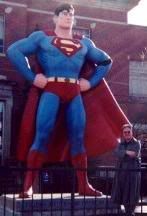| Pop Culture Gadabout | ||
|
Friday, March 26, 2010 ( 3/26/2010 09:53:00 PM ) Bill S. WEEKEND PET PIC: Here's a simple shot of Savannah Cat:  THE USUAL NOTE: For more cool pics of companion animals, please check out Modulator's "Friday Ark." # | Thursday, March 25, 2010 ( 3/25/2010 07:32:00 AM ) Bill S.  “I KINDA GET THE FEELING . . .THESE GUYS ARE ALWAYS TWO STEPS AHEAD OF ME.” The second volume of Tokyopop’s shojo bakery comedy, Happy Café, finds our core trio settling into their established sitcom roles: spunky heroine/narrator Uru remains her irrepressibly cheerful, slapstick prone self; surly baker Shindo continues to display occasional flashes of nice-guy-ness (making a low-sugar Mont Blanc for a diabetic regular, for instance, and not charging him extra); blond Ichiro’s propensity for falling asleep at inopportune times remains unchanged. To spice things up, creator Kou Matsuzuki introduces a par of sibling baking rivals from a neighboring mall café, one of which has an apparently unrequited crush on narcoleptic Ichiro. Uru’s stepmom makes an appearance in the book’s last chapter, officially to check up on the girl but story wise to throw a romantic entanglement into the next volume. It’s Happy Café moves to Cougar Town? Maybe. “I KINDA GET THE FEELING . . .THESE GUYS ARE ALWAYS TWO STEPS AHEAD OF ME.” The second volume of Tokyopop’s shojo bakery comedy, Happy Café, finds our core trio settling into their established sitcom roles: spunky heroine/narrator Uru remains her irrepressibly cheerful, slapstick prone self; surly baker Shindo continues to display occasional flashes of nice-guy-ness (making a low-sugar Mont Blanc for a diabetic regular, for instance, and not charging him extra); blond Ichiro’s propensity for falling asleep at inopportune times remains unchanged. To spice things up, creator Kou Matsuzuki introduces a par of sibling baking rivals from a neighboring mall café, one of which has an apparently unrequited crush on narcoleptic Ichiro. Uru’s stepmom makes an appearance in the book’s last chapter, officially to check up on the girl but story wise to throw a romantic entanglement into the next volume. It’s Happy Café moves to Cougar Town? Maybe.The bulk of volume two, however, is devoted to a competition between the two bakeshops. Our accident-prone girl winds up spraining Shindo’s mixing wrist three days before the contest, adding a minuscule dose of suspense to the proceedings, but since we know our threesome will have to close down Café Bonheur if they lost, the outcome is never really in doubt. Unlike more hard-core foodee manga like Yakitate! Japan, the focus isn’t on the actual contest – no loving close-ups of food and food prep here, unfortunately – but on the character interactions. And since none of our core trio really offers anything new in this teen-rated volume, its success rests on the predominately teen girl readership’s attachment to its affable storytelling. Though it may at times seem overly sweet to a churlish geezer like yours truly, Matsuzuki – like her baker Shindo – knows when to replace the sugar with something slightly healthier. Labels: sixty-minute manga # |Wednesday, March 24, 2010 ( 3/24/2010 06:50:00 AM ) Bill S. MID-WEEK MUSIC VID: Here’s David Jo and Ellen Shipley doing a Brechtian version of “Alabama Song” from a PBS series devoted to Kurt Weill tunes: # | Sunday, March 21, 2010 ( 3/21/2010 08:27:00 AM ) Bill S. “A SLIGHTLY WEIRD JOB” One of a series of graphic novels commissioned by the Louvre, Eric Liberge’s On the Odd Hours (NBM/ComicsLit) concerns a broody, somewhat self-destructive deaf mute named Bastien who is hired as a watchman by the museum to watch over the “Odd Hours,” those times late at night when the masterworks of art come alive to bare their souls away from the public eye. Instructed in this “slightly weird job” by Fu Zhi Ha, the aged Odd Hours watchman, Bastien finds his connections to the daytime world growing less significant: his bourgeois deaf girlfriend doesn’t understand his growing obsession with the museum, and we know from the first time we see the two of ‘em together that there’ll be a blow-up in the relationship. If its basic set-up sounds like the Art School version of A Night at the Museum, Liberge is after more than just kid’s comic fantasy in On the Odd Hours. The late night moments are played for sinister beauty, not comedy, and embedded within this short 72-page graphic novel is a critical consideration of the very function of public art museums. “Those who consume art, the public, people in general, appreciate the artwork for their own pleasure,” Bastien’s mentor states early in the book. “They only stay on the surface. It’s all they know how to do!” Only when these “orphan” works are removed from a large gawking public, considered in solitude, can our hero approach their truest meaning. The sequences where the museum’s artworks come alive are the book’s big set pieces, of course, and Liberge pulls these moments off with aplomb, even if some of the artworks depicted in the finale are a little too ethereally rendered to get a clear sense of what they are. Because several of the characters are deaf, many of the word balloons trail down to signing hands; the artist’s command of his people’s anatomy is so strong that he makes this potentially distancing visual device convincing. In the end it adds to the artist’s consideration of a world where the only thing that matters is what we see. Labels: art comics # | |
|
|

